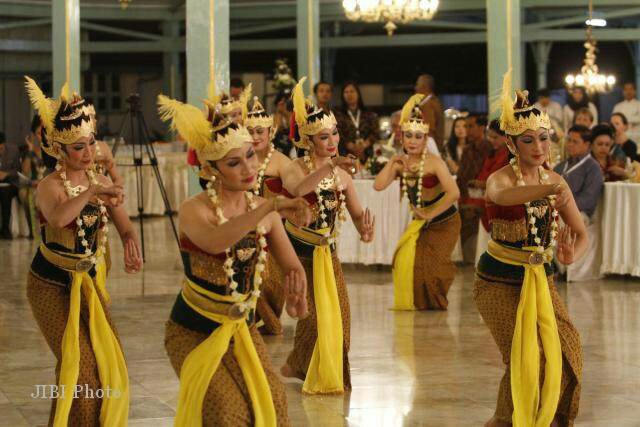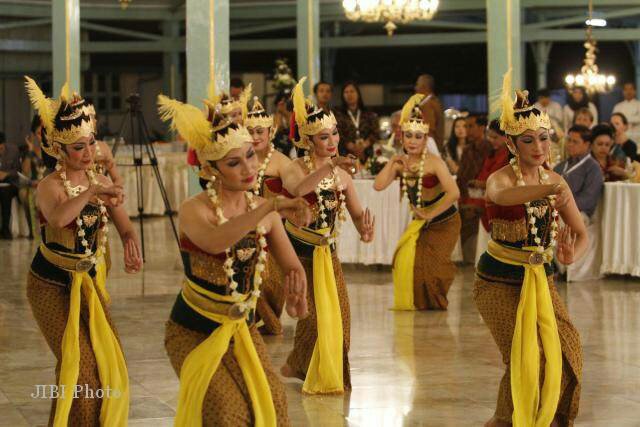 Yogyakarta dance is one of the typical of this student city. It seems less complete our tradition if not yet explore the type of dance area of Yogyakarta. Or lest my sisters, brothers and sisters loyal tradisikita now is back and forth looking for articles about this traditional dance of Yogyakarta? Immediately buddy, below we will soon get to know six traditional dances of Yogyakarta.
Yogyakarta dance is one of the typical of this student city. It seems less complete our tradition if not yet explore the type of dance area of Yogyakarta. Or lest my sisters, brothers and sisters loyal tradisikita now is back and forth looking for articles about this traditional dance of Yogyakarta? Immediately buddy, below we will soon get to know six traditional dances of Yogyakarta.
1. Golek Ayun-Ayun Dance
Golek Ayun-ayun Dance which is one of the traditional dances of Yogyakarta created by (Alm) KRT Sasmita Dipura (Romo Sas). This dance is shown to greet the guest of honor and is usually performed by two dancers. His movements are very gentle and meaningful. as if the dancer was preening. The other movements also show as if he was embroidering. Golek Dancing Dancer wearing a matching black velvet dress matching with subordinate white batik cloth. The pink-winged peacock crown added beautify the appearance of the dancer This dance can be witnessed every Sunday in Pendapa (Bangsal) Sri Manganti, Keraton Jogjakarta from 10.00 am to 12.00 pm. There are usually three types of dance that are displayed. Golek Ayun-ayun Dance, Beksan Srikandi Suradewati and Sendratari Arjuna Wiwaha

2. Beksan Srikandi Suradewati Dance
Beksan Srikandi Suradewati dance is a traditional dance of Yogyakarta that tells about the battle of Dewi Suradewati with Dewi Srikandhi taken from Mahabaratha fiber. Suradewati is Prabhu Dasalengkara’s sister who wants to make Dewi Siti Sendari as his wife, so Suradewati is sent by her sister to propose Dewi Siti Sendari for her. In fact Dewi Siti Sendari has been mated with Raden Abimanyu. Seeing this reality, Suradewati still forced to edit Dewi Siti Sendari, then there was a feud between Suradewati against Dewi Srikandhi, who defended Raden Abimanyu. In the battle, it turns out that Dewi Srikandhi is superior and ends with his victory.

3. Arjuna Wiwaha Dance
ArjunaWiwaha dance is one of the traditional dances performed at Yogyakarta Palace. Arjuna Wiwaha dance tells when Arjuna who meditated in Indrakila experienced various temptations. One of his temptations was when he was tested by the Gods by sending seven angels who were told to tempt Arjuna to fail in his hermitage. But because of his courage, the angels did not succeed in seducing Arjuna, Indra came to himself in disguise as an old Brahmana. They talked about religion and Indra expressed his identity and left. Then after that there was a pig that came on a rampage and Arjuna shoots it. But at the same time there was an old hunter coming and also shooting it. It turns out that this hunter is Batara Shiva. After that Arjuna was given the task to kill Niwatakawaca a giant who disturbs the heaven. Arjuna succeeded in his duty and was given a gift by the Gods by being allowed to marry these seven nymphs.

4. Langen Dance Mandra Wanara
Langen Mandra Wanara is a form of Javanese dance drama that utilizes dance material of Yogyakarta classical tradition. The dance drama depicting many weras (monkeys) and functioning as entertainment is a development of the existing dance drama, namely Langendriya sourced from the Damarwulan Fiber. Both Langendriya and Langen Mandra Wanara, presented in the form of dance with jengkok or jengkok1 position) accompanied by a dialog in the form of tembang macapat. The difference, which is also a development, is the play that was delivered. If lokan brought in the dance drama Langendriya sourced from another story, then Langen Mandra Wanara sourced from Ramayana stories, such as: Subali Lena, Senggana Duta, Rahwana Gugur, and so forth. To be able to perform Langen Mandra Wanara it takes about 45 people consisting of 30 players, 13 gamelan players, one waranggana, and one dalang. The dalang's function is to regulate behavior and assist the actors in the delivery of stories by doing suluk (monologue). The costumes and makeup used during the show follow the shadow puppet patron. Langen Mandra Wanara shows are usually held at ceremonies, such as weddings and other big days. The show takes approximately seven hours at night and is usually housed in a pendopo with lamp lighting or petromax electric. Performances Langen Mandro Wanara usually equipped with a complete Javanese gamelan instruments (pelog and selendro). The costumes and makeup used also follow the shadow puppet patron. In conveying the story of the players using the dialogue done with nembang (singing) while the activity on stage is realized through dance performed with jengkeng (standing on the knee). Performance Langen Mondro Wanoro is using the concept of a stage-shaped arena and is usually done in pendopo.Sebagai lighting equipment is now used petromak. The instrument used is a complete Java gamelan that is pelog and slendro, or slendro only.
